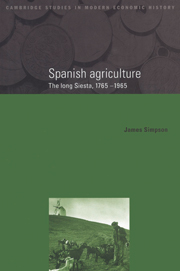Book contents
- Frontmatter
- Contents
- List of illustrations
- List of tables
- Acknowledgements
- Note on the regional division of Spain
- Abbreviations and conventions
- Introduction
- Part I The relative backwardness of Spanish agriculture
- Part II Traditional technologies and market opportunities, 1765–1880
- 3 Agricultural growth and stagnant technology
- 4 Agricultural specialisation and the growth of markets
- Part III The limits to technical change, 1880–1936
- Part IV Markets and institutions, 1880–1936
- Part V The State and the end of traditional agriculture
- Conclusion
- Appendix Estimates of agricultural output and consumption in nineteenth-century Spain
- Bibliography
- Index
4 - Agricultural specialisation and the growth of markets
Published online by Cambridge University Press: 04 December 2009
- Frontmatter
- Contents
- List of illustrations
- List of tables
- Acknowledgements
- Note on the regional division of Spain
- Abbreviations and conventions
- Introduction
- Part I The relative backwardness of Spanish agriculture
- Part II Traditional technologies and market opportunities, 1765–1880
- 3 Agricultural growth and stagnant technology
- 4 Agricultural specialisation and the growth of markets
- Part III The limits to technical change, 1880–1936
- Part IV Markets and institutions, 1880–1936
- Part V The State and the end of traditional agriculture
- Conclusion
- Appendix Estimates of agricultural output and consumption in nineteenth-century Spain
- Bibliography
- Index
Summary
In the mid-eighteenth century, the low purchasing power of much of the population placed it at risk from harvest failure. A slow and costly transport system, inefficient transmission of market-place information, and government interference with the market mechanism all implied that short-term local shortages were difficult to overcome and that local prices of basic foodstuffs might double or more in a short space of time. To protect themselves from adverse price movements, farmers dedicated a significant part of their resources to growing basic food crops, regardless of the suitability of their land for such production. By contrast, the more integrated markets to be found by the end of the nineteenth century not only permitted farmers greater security of supplies, but also allowed them the possibility of specialising in those crops most suited to local climatic and soil conditions, especially those that factor and product prices showed were most profitable.
In the first section I argue that Spain's transport system improved significantly over the century prior to the railways although, in comparison with France, the country was to continue to suffer severely from an inadequate road network and an almost total lack of inland water communications. Greater market integration, however, was not just a question of public works; it also implied a complete overhaul of the Ancien Régime's concept of the market.
- Type
- Chapter
- Information
- Spanish AgricultureThe Long Siesta, 1765–1965, pp. 80 - 98Publisher: Cambridge University PressPrint publication year: 1996



